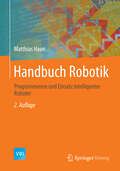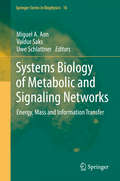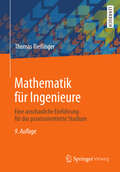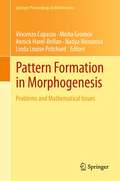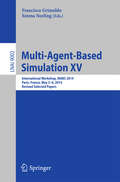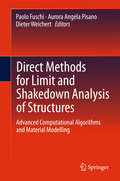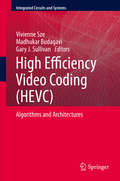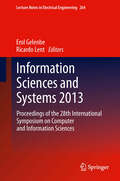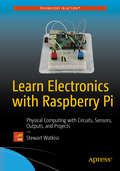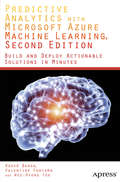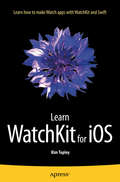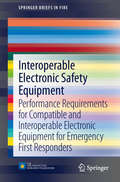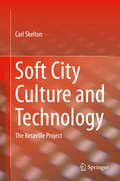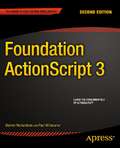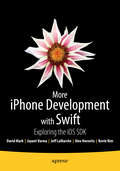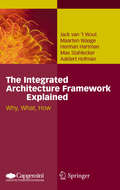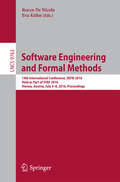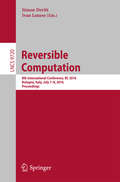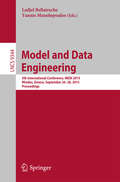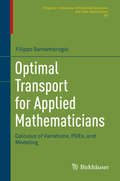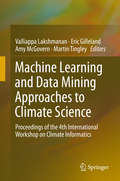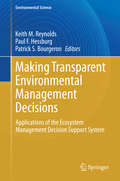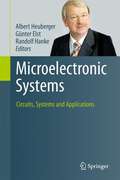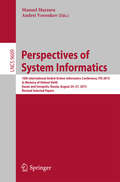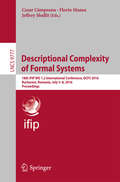- Table View
- List View
Handbuch Robotik
by Matthias HaunZiele des Buches ist es, den Roboter als lernendes System aufzufassen, es als wissensbasiertes Modellsystem zu konzeptionalisieren und dieses System durch intelligente, rechnerbasierte Technologien in funktionaler Hinsicht zu implementieren. Das Ziel eines Ansatzes liegt in der Steigerung des systemischen Intelligenzquotienten (sIQ). Erreichbar wird dieses Ziel durch eine Modellierung auf Basis der Kognitionstheorie und der konkreten (Aus) implementierung dieser Modelle durch den Einsatz der Cognitive Computing Technologien unter der Programmiersprache Java.
Systems Biology of Metabolic and Signaling Networks
by Miguel A. Aon Valdur Saks Uwe SchlattnerSystems Biology represents a new paradigm aiming at a whole-organism-level understanding of biological phenomena, emphasizing interconnections and functional interrelationships rather than component parts. The study of network properties, and how they control and regulate behavior from the cellular to organism level, constitutes a main focus of Systems Biology. This book addresses from a novel perspective a major unsolved biological problem: understanding how a cell works and what goes wrong in pathology. The task undertaken by the authors is in equal parts conceptual and methodological, integrative and analytical, experimental and theoretical, qualitative and quantitative, didactic and comprehensive. Essentially, they unravel the spatio-temporal unfolding of interacting mass-energy and information networks at the cellular and organ levels, as well as its modulation through activation or repression by signaling networks to produce a certain phenotype or (patho)physiological response. Starting with the historical roots, in thirteen chapters this work explores the Systems Biology of signaling networks, cellular structures and fluxes, organ and microorganism functions. In doing so, it establishes the basis of a 21st century approach to biological complexity.
Mathematik für Ingenieure: Eine anschauliche Einführung für das praxisorientierte Studium
by Thomas Rießinger"Mathematik in entspannter Atmosphäre" ist das Leitbild dieses leicht verständlichen Lehrbuchs. Im Erzählstil und mit vielen Beispielen beleuchtet der Autor nicht nur die Höhere Mathematik, sondern er stellt auch den Lehrstoff in Bezug zu den Anwendungen. Die gesamte für den Ingenieurstudenten wichtige Mathematik wird in einem Band behandelt. Dies gelingt durch Verzicht auf abstrakte Höhen und durch eine prüfungsgerechte Stoffauswahl, die sich streng an den Bedürfnissen des späteren Ingenieurs ausrichtet. Das Buch kann vorlesungsbegleitend oder zum Selbststudium eingesetzt werden. Die 159 Übungsaufgaben mit Lösungen unterstützen das Einüben des Lehrstoffs und sind im Band "Übungsaufgaben zur Mathematik für Ingenieure" ausführlich durchgerechnet. Der "Brückenkurs" auf http://extras.springer.com/2013/978-3-642-36858-5 erleichtert Anfängern den Einstieg.
Pattern Formation in Morphogenesis
by Vincenzo Capasso Annick Harel-Bellan Misha Gromov Linda Louise Pritchard Nadya MorozovaPattern Formation in Morphogenesis is a rich source of interesting and challenging mathematical problems. The volume aims at showing how a combination of new discoveries in developmental biology and associated modelling and computational techniques has stimulated or may stimulate relevant advances in the field. Finally it aims at facilitating the process of unfolding a mutual recognition between Biologists and Mathematicians of their complementary skills, to the point where the resulting synergy generates new and novel discoveries. It offers an interdisciplinary interaction space between biologists from embryology, genetics and molecular biology who present their own work in the perspective of the advancement of their specific fields, and mathematicians who propose solutions based on the knowledge grasped from biologists.
Multi-Agent-Based Simulation XV
by Francisco Grimaldo Emma NorlingThis book constitutes the thoroughly refereed post-conference proceedings of the 15th International Workshop on Multi-Agent-Based Simulation, MABS 2014, held in Paris, France, in May 2014. The workshop was held in conjunction with the 13th International Conference on Autonomous Agents and Multiagent Systems, AAMAS 2014. The 17 revised full papers included in this volume were carefully selected from numerous submissions. The papers are organized in topical sections on simulation methodologies, simulation of social behaviour, data and multi-agent-based simulation and applications.
Direct Methods for Limit and Shakedown Analysis of Structures
by Dieter Weichert Paolo Fuschi Aurora Angela PisanoArticles in this book examine various materials and how to determine directly the limit state of a structure, in the sense of limit analysis and shakedown analysis. Apart from classical applications in mechanical and civil engineering contexts, the book reports on the emerging field of material design beyond the elastic limit, which has further industrial design and technological applications. Readers will discover that "Direct Methods" and the techniques presented here can in fact be used to numerically estimate the strength of structured materials such as composites or nano-materials, which represent fruitful fields of future applications. Leading researchers outline the latest computational tools and optimization techniques and explore the possibility of obtaining information on the limit state of a structure whose post-elastic loading path and constitutive behavior are not well defined or well known. Readers will discover how Direct Methods allow rapid and direct access to requested information in mathematically constructive manners without cumbersome step-by-step computation. Both researchers already interested or involved in the field and practical engineers who want to have a panorama of modern methods for structural safety assessment will find this book valuable. It provides the reader with the latest developments and a significant amount of references on the topic.
High Efficiency Video Coding (HEVC)
by Vivienne Sze Madhukar Budagavi Gary J. SullivanThis book provides developers, engineers, researchers and students with detailed knowledge about the High Efficiency Video Coding (HEVC) standard. HEVC is the successor to the widely successful H. 264/AVC video compression standard, and it provides around twice as much compression as H. 264/AVC for the same level of quality. The applications for HEVC will not only cover the space of the well-known current uses and capabilities of digital video - they will also include the deployment of new services and the delivery of enhanced video quality, such as ultra-high-definition television (UHDTV) and video with higher dynamic range, wider range of representable color, and greater representation precision than what is typically found today. HEVC is the next major generation of video coding design - a flexible, reliable and robust solution that will support the next decade of video applications and ease the burden of video on world-wide network traffic. This book provides a detailed explanation of the various parts of the standard, insight into how it was developed, and in-depth discussion of algorithms and architectures for its implementation.
Information Sciences and Systems 2013
by Erol Gelenbe Ricardo LentBased on a rigorous selection from 58 proposals coming from across the world, this volume will include some of the most recent ideas and technical results in computer systems, computer science, and computer-communication networks. The book will offer the reader with a timely access to innovative research from many different areas of the world where advances in computing and communications are created.
Learn Electronics with Raspberry Pi
by Stewart WatkissLearning electronics can be tremendous fun -- your first flashing LED circuit is a reason to celebrate! But where do you go from there, and how can you move into more challenging projects without spending a lot of money on proprietary kits? One excellent answer is Raspberry Pi. Raspberry Pi is everywhere, it's inexpensive, and it's a wonderful tool for teaching about electronics and programming. Learn Electronics with Raspberry Pi shows you how to make a variety of cool projects using the Pi with programming languages like Scratch and Python, with no experience necessary. You'll learn how the Pi works, how to work with Raspbian Linux on the Pi, and how to design and create electronic circuits. You'll then create projects like an arcade game, disco lights, and infrared transmitter, and an LCD display. You'll also learn how to control Minecraft's Steve with a joystick and how to build a Minecraft house with a Pi, and even how to control a LEGO train with a Pi. You'll even learn how to create your own robot, including how to solder and even design a printed circuit board! Author Stewart Watkiss brings a ton of experience and a sense of fun to this delicious array of Pi projects. He's the founder of Penguin Tutor, an enthusiastic STEM ambassador, and the technical reviewer of Mastering the Raspberry Pi and Learn Raspberry Pi with Linux. What you'll learn Learn how to design and build electronic circuits, and even how to make a PCB Learn how to make fun projects like an arcade game, a robot, and a Minecraft controller while learning about sensors and how devices talk to each other Get started programming the Pi with Scratch and Python Who this book is for Makers, students, and teachers who want to learn about electronics and programming with the fun and low-cost Raspberry Pi.
Predictive Analytics with Microsoft Azure Machine Learning
by Roger Barga Valentine Fontama Wee Hyong TokPredictive Analytics with Microsoft Azure Machine Learning, Second Edition is a practical tutorial introduction to the field of data science and machine learning, with a focus on building and deploying predictive models. The book provides a thorough overview of the Microsoft Azure Machine Learning service released for general availability on February 18th, 2015 with practical guidance for building recommenders, propensity models, and churn and predictive maintenance models. The authors use task oriented descriptions and concrete end-to-end examples to ensure that the reader can immediately begin using this new service. The book describes all aspects of the service from data ingress to applying machine learning, evaluating the models, and deploying them as web services. Learn how you can quickly build and deploy sophisticated predictive models with the new Azure Machine Learning from Microsoft. What's New in the Second Edition? Five new chapters have been added with practical detailed coverage of: Python Integration - a new feature announced February 2015 Data preparation and feature selection Data visualization with Power BI Recommendation engines Selling your models on Azure Marketplace What you'll learn A structured introduction to Data Science and its best practices An introduction to the new Microsoft Azure Machine Learning service, explaining how to effectively build and deploy predictive models Practical skills such as how to solve typical predictive analytics problems like propensity modeling, churn analysis, product recommendation, and visualization with Power BI A practical way to sell your own predictive models on the Azure Marketplace Who this book is for Data Scientists, Business Analysts, BI Professionals and Developers who are interested in expanding their repertoire of skill applied to machine learning and predictive analytics, as well as anyone interested in an in-depth explanation of the Microsoft Azure Machine Learning service through practical tasks and concrete applications. The reader is assumed to have basic knowledge of statistics and data analysis, but not deep experience in data science or data mining. Advanced programming skills are not required, although some experience with R programming would prove very useful. Table of Contents Part 1: Introducing Data Science and Microsoft Azure Machine Learning 1. Introduction to Data Science 2. Introducing Microsoft Azure Machine Learning 3. Data Preparation 4. Integration with R 5. Integration with Python Part 2: Statistical and Machine Learning Algorithms 6. Introduction to Statistical and Machine Learning Algorithms Part 3: Practical applications 7. Building Customer Propensity Models 8. Visualizing Your Models with Power BI 9. Building Churn Models 10. Customer Segmentation Models 11. Building Predictive Maintenance Models 12. Recommendation Systems 13. Consuming and Publishing Models on Azure Marketplace 14. Cortana Analytics
Learn WatchKit for iOS
by Kim TopleyLearn WatchKit for iOS covers the development of applications for the new Apple Watch using the WatchKit framework in iOS 8 and the Swift programming language. In this book, an Apple Watch application is an extension to an existing iOS app and is packaged and submitted to the App Store along with it. Using a suite of simple examples, Kim Topley, co-author of Beginning iPhone Development with Swift, introduces and explains every feature of WatchKit and the associated technologies that you'll need to understand to build Apple Watch applications for iOS 8, culminating in a complete WatchKit application that shows weather forecast information for various cities around the world on the Apple Watch. What you'll learn How to build an application for the Apple Watch as an extension of an existing iOS app. How to use all the features of the WatchKit framework in iOS 8. How to integrate your Watch app with its hosting iOS app and how to communicate between them. How to build a Glance for your WatchKit app to make the most useful information more easily available to your users. How to handle notifications. How to use handoff to allow the user to quickly switch to your WatchKit app from its Glance or when handling a notification. How to build, test and debug your Watch App on the simulator and on a real watch. Who this book is for This book is for existing iOS developers who want to understand and use WatchKit to extend their application onto the Apple Watch. Readers are assumed to have basic knowledge of iOS development. Table of Contents Chapter 1. Welcome to the Apple Watch Chapter 2. Interface Controllers and Layout Chapter 3. Watch User Interface Objects Chapter 4. More Watch User Interface Objects Chapter 5. Controller Navigation Chapter 6. Tables and Menus Chapter 7. Building a WatchKit App Chapter 8. Glances, Settings, and Handoff Chapter 9. Notifications
Interoperable Electronic Safety Equipment: Performance Requirements for Compatible and Interoperable Electronic Equipment for Emergency First Responders
by Casey C GrantFirefighters and other emergency first responders use a huge variety of highly specialized and critical technologies for personal protection. These technologies, ranging from GPS to environmental sensing to communication devices, often run on different systems with separate power supplies and operating platforms. How these technological components function in a single synergistic system is of critical interest to firefighter end-users seeking efficient tools. Interoperable ESE states that a standardized platform for electronic safety equipment (ESE) is both logical and essential. This book develops an inventory of existing and emerging electronic equipment categorized by key areas of interest to the fire service, documents equipment performance requirements relevant to interoperability, including communications and power requirements, and develops an action plan toward the development of requirements to meet the needs of emergency responders. This book is intended for practitioners as a tool for understanding interoperability concepts and the requirements of the fire service landscape. It offers clear recommendations for the future to help ensure efficiency and safety with fire protection equipment. Researchers working in a related field will also find the book valuable.
Soft City Culture and Technology
by Carl SkeltonSoft City Culture and Technology: The Betaville Project discusses the complete cycle of conception, development, and deployment of the Betaville platform. Betaville is a massively participatory online environment for distributed 3D design and development of proposals for changes to the built environment- an experimental integration of art, design, and software development for the public realm. Through a detailed account of Betaville from a Big Crazy Idea to a working "deep social medium", the author examines the current conditions of performance and accessibility of hardware, software, networks, and skills that can be brought together into a new form of open public design and deliberation space, for and spanning and integrating the disparate spheres of art, architecture, social media, and engineering. Betaville is an ambitious enterprise, of building compelling and constructive working relationships in situations where roles and disciplinary boundaries must be as agile as the development process of the software itself. Through a considered account and analysis of the interdependencies between Betaville's project design, development methods, and deployment, the reader can gain a deeper understanding of the potential socio-technical forms of New Soft Cities: blended virtual-physical worlds, whose "public works" must ultimately serve and succeed as massively collaborative works of art and infrastructure.
Foundation ActionScript 3
by Darren Richardson Paul MilbourneActionScript 3 is a full-fledged programming language, with complete object-oriented capabilities, event handling, sound and video support, drawing capabilities, support for regular expressions, and much more. Whether you are just starting out on the road to computer programming and animation or an experienced developer who wants to learn a new language, you'll find all you need to know in Foundation ActionScript 3. Starting with the fundamentals, you'll learn how to add interactivity to your Flash movies by using ActionScript objects, manipulating sound and video, and harnessing the power of regular expressions and XML. The book concludes with two case studies to consolidate what you've learned and introduce some additional advanced techniques. You'll gain a solid understanding of the exciting world of ActionScript 3 and see how everything fits together, so you'll be able to build your own professional applications. The sensible layout of the book makes it easy to find information about specific techniques. It focuses on the essential skills that will enable you to get up and running quickly. With this book as your guide, you'll be creating killer Flash applications before you know it. What you'll learn Learn the fundamentals of ActionScript 3. Use ActionScript 3's object-oriented features Manipulate sound and video to produce exciting modern web applications Work with XML as your data source Who this book is for Whether you're completely new to ActionScript or you're coming from a previous version, Foundation ActionScript 3 will teach you all you need to know to get up and running with AS3 in no time. Table of Contents Getting Started with ActionScript 3 ActionScript 3 Fundamentals Objects and Classes Working with the Display Creating Vector Graphics with the Drawing API User Interaction and More with Events Working with Video Using Audio Working with Components Regular Expressions Using XML Case Study: Creating a Dynamic Image Viewer Getting Started with Flex Flex by Example
More iPhone Development with Swift
by Alex Horovitz David Mark Jayant Varma Jeff Lamarche Kevin KimInterested in iPhone and iPad apps development? Want to learn more? Whether you are a relative newcomer to iPhone and iPad or iOS development or an old hand looking to expand your horizons, we have the perfect Swift-flavored book for you. (Source code has been updated to reflect Xcode 6. 3. 2 and Swift 1. 2!) The update to the bestselling More iPhone Development by Dave Mark and Jeff LaMarche, More iPhone Development with Swift digs deeper into the new Apple Swift programming language and iOS 8 SDK, explaining complex concepts and techniques in the same friendly, easy-to-follow style you've come to expect. More iPhone Development with Swift covers topics like Swift, Core Data, peer-to-peer networking using Multipeer Connectivity, working with data from the web, MapKit, in-application e-mail, Camera Live-Previews integration, Barcode scanning and more. All the concepts and APIs are clearly presented with code snippets you can customize and use, as you like, in your own apps. You'll journey through coverage of concurrent programming and some advanced techniques for debugging your applications. What you'll learn All about Swift, Core Data: key concepts and techniques for writing larger applications How to leverage the new Swift programming language with the new iOS SDK How to utilize a variety of networking mechanisms, including peer-to-peer connections over Bluetooth/WiFi using Multipeer Connectivity Essentials of concurrent programming and advanced debugging techniques Tips on working with data from the web and the cloud, including Apple's iCloud Who this book is for This book is a perfect more advanced companion to Beginning iPhone Development with Swift. So, this book is for those who have some experience with Swift and the iOS SDK already and for readers of the Beginning iPhone Development book. Table of Contents Chapter 1: Here We Go Round Again Chapter 2: Core Data, What, Why and How Chapter 3: A Super Start Chapter 4: The Devil in the Detail View Chapter 5: Preparing for Change: Migrations and Versioning Chapter 6: Custom Managed Objects Chapter 7: Relationships, Fetched Properties, and Expressions Chapter 8: Behind Every iCloud Chapter 9: Peer-to-Peer Over Bluetooth Using Multipeer Connectivity Chapter 10: MapKit Chapter 11: Messaging: Mail, Social, and iMessage Chapter 12: Media Library Access and Playback Chapter 13: Lights, Camera and Action Chapter 14: Interface Builder and Storyboards Chapter 15: Unit Testing, Debugging, and Instruments Chapter 16: The Road Goes Ever On
The Integrated Architecture Framework Explained
by Maarten Waage Herman Hartman Max Stahlecker Jack Van'T Wout Aaldert HofmanThis book captures and communicates the wealth of architecture experience Capgemini has gathered as a member of The Open Group - a vendor- and technology-neutral consortium formed by major industry players - in developing, deploying, and using its "Integrated Architecture Framework" (IAF) since its origination in 1993. Today, many elements of IAF have been incorporated into the new version 9 of TOGAF, the related Open Group standard. The authors, all working on and with IAF for many years, here provide a full reference to IAF and a guide on how to apply it. In addition, they describe in detail the relations between IAF and the architecture standards TOGAF and Archimate and other development or process frameworks like ITIL, CMMI, and RUP. Their presentation is targeted at architects, project managers, and process analysts who have either considered or are already working with IAF - they will find many roadmaps, case studies, checklists, and tips and advice for their daily work.
Software Engineering and Formal Methods
by Rocco De Nicola Eva KühnThis book constitutes the proceedings of the 14th International Conference on Software Engineering and Formal Methods, SEFM 2016, held as part of STAF 2016, in Vienna, Austria, in July 2016. The 20 full and 5 short papers presented in this volume were carefully reviewed and selected from 88 submissions. They were organized in topical sections named: concurrency and non-interference; program analysis; model checking; verification; interaction and adaptation; and development methods.
Reversible Computation
by Ivan Lanese Simon DevittThis book constitutes the refereed proceedings of the 8th International Conference on Reversible Computation, RC 2016, held in Bologna, Italy, in July 2016. The 18 full and 5 short papers included in this volume were carefully reviewed and selected from 38 submissions. The papers are organized in topical sections named: process calculi; reversible models; programming languages; quantum computing; quantum programming; circuit theory; and syntheses.
Model and Data Engineering
by Ladjel Bellatreche Yannis ManolopoulosThis book constitutes the refereed proceedings of the 5th International Conference on Model and Data Engineering, MEDI 2015, held in Rhodes, Greece, in September 2015. The 18 full papers and 9 short papers presented together with 2 invited talks were carefully reviewed and selected from 55 submissions. The papers are organized in topical sections such as modeling and meta modeling; ontology-based modeling, reasoning and reuse; event-B and modeling languages; context modeling and model transformation; data mining; query processing; modeling activities and inference; prediction and recommendation; requirement and systems engineering.
Optimal Transport for Applied Mathematicians
by Filippo SantambrogioThis monograph presents a rigorous mathematical introduction to optimal transport as a variational problem, its use in modeling various phenomena, and its connections with partial differential equations. Its main goal is to provide the reader with the techniques necessary to understand the current research in optimal transport and the tools which are most useful for its applications. Full proofs are used to illustrate mathematical concepts and each chapter includes a section that discusses applications of optimal transport to various areas, such as economics, finance, potential games, image processing and fluid dynamics. Several topics are covered that have never been previously in books on this subject, such as the Knothe transport, the properties of functionals on measures, the Dacorogna-Moser flow, the formulation through minimal flows with prescribed divergence formulation, the case of the supremal cost, and the most classical numerical methods. Graduate students and researchers in both pure and applied mathematics interested in the problems and applications of optimal transport will find this to be an invaluable resource.
Machine Learning and Data Mining Approaches to Climate Science
by Valliappa Lakshmanan Eric Gilleland Amy Mcgovern Martin TingleyThis book presents innovative work in Climate Informatics, a new field that reflects the application of data mining methods to climate science, and shows where this new and fast growing field is headed. Given its interdisciplinary nature, Climate Informatics offers insights, tools and methods that are increasingly needed in order to understand the climate system, an aspect which in turn has become crucial because of the threat of climate change. There has been a veritable explosion in the amount of data produced by satellites, environmental sensors and climate models that monitor, measure and forecast the earth system. In order to meaningfully pursue knowledge discovery on the basis of such voluminous and diverse datasets, it is necessary to apply machine learning methods, and Climate Informatics lies at the intersection of machine learning and climate science. This book grew out of the fourth workshop on Climate Informatics held in Boulder, Colorado in Sep. 2014.
Making Transparent Environmental Management Decisions
by Keith M. Reynolds Paul F. Hessburg Patrick S. BourgeronSince 1997, the Ecosystem Management Decision Support (EMDS) system has been used around the world to support environmental analysis and planning in many different application areas, and it has been applied over a wide range of geographic scales, from forest stands to entire countries. An extensive sampling of this diversity of applications is presented in section 2, in which EMDS application developers describe the varied uses of the system. These accounts, together with the requisite background in section 1, provide valuable practical insights into how the system can be applied in the general domain of environmental management.
Microelectronic Systems
by Albert Heuberger Randolf Hanke Günter Elst Karlheinz Kirsch Janina HeppnerThis book is dedicated to Prof. Dr. Heinz Gerhäuser on the occasion of his retirement both from the position of Executive Director of the Fraunhofer Institute for Integrated Circuits IIS and from the Endowed Chair of Information Technologies with a Focus on Communication Electronics (LIKE) at the Friedrich-Alexander-Universität Erlangen-Nürnberg. Heinz Gerhäuser's vision and entrepreneurial spirit have made the Fraunhofer IIS one of the most successful and renowned German research institutions. He has been Director of the Fraunhofer IIS since 1993, and under his leadership it has grown to become the largest of Germany's 60 Fraunhofer Institutes, a position it retains to this day, currently employing over 730 staff. Likely his most important scientific as well as application-related contribution was his pivotal role in the development of the mp3 format, which would later become a worldwide success. The contributions to this Festschrift were written by both Fraunhofer IIS staff and external project team members in appreciation of Prof. Dr. Gerhäuser's lifetime academic achievements and his inspiring leadership at the Fraunhofer IIS. The papers reflect the broad spectrum of the institute's research activities and are grouped into sections on circuits, information systems, visual computing, and audio and multimedia. They provide academic and industrial researchers in fields like signal processing, sensor networks, microelectronics, and integrated circuits with an up-to-date overview of research results that have a huge potential for cutting-edge industrial applications.
Perspectives of System Informatics
by Manuel Mazzara Andrei VoronkovThis book constitutes the refereed proceedings of the 10th International Andrei Ershov Informatics Conference, PSI 2015, held in Kazan and Innopolis, Russia, in August 2015. The 2 invited and 23 full papers presented in this volume were carefully reviewed and selected from 56 submissions. The papers cover various topics related to the foundations of program and system development and analysis, programming methodology and software engineering and information technologies.
Descriptional Complexity of Formal Systems
by Jeffrey Shallit Florin Manea Cezar CâmpeanuThis book constitutes the refereed proceedings of the 17th International Conference on Descriptional Complexity of Formal Systems, DCFS 2015, held in Waterloo, ON, Canada, in June 2015. The 23 full papers presented together with 2 invited talks were carefully reviewed and selected from 29 submissions. The subject of the workshop was descriptional complexity. Roughly speaking, this field is concerned with the size of objects in various mathematical models of computation, such as finite automata, pushdown automata, and Turing machines. Descriptional complexity serves as a theoretical representation of physical realizations, such as the engineering complexity of computer software and hardware. It also models similar complexity phenomena in other areas of computer science, including unconventional computing and bioinformatics.
